How to Choose the Right Ophthalmic Equipment for Your Practice
Choosing the right ophthalmic equipment requires careful consideration of your practice's needs, budget, and future goals. Rigor Instruments offer exceptional precision and reliability, making them an excellent choice for modern ophthalmic practices.

Selecting the right ophthalmic equipment is one of the most critical decisions you’ll make for your practice. The quality and functionality of your equipment directly impact patient care, diagnostic accuracy, and overall practice efficiency. In this guide, we’ll break down how to make informed choices that align with your practice's needs and budget.
Understanding Your Practice’s Needs
Before diving into the details, start by analyzing your practice. Are you a general ophthalmologist, or do you specialize in retina treatments, glaucoma care, or pediatric ophthalmology? Your focus will determine the type of equipment required.
Budget is another key factor. Whether you’re starting a new practice or upgrading an existing one, balancing affordability with quality is essential.
Types of Ophthalmic Equipment
Diagnostic Equipment
- Slit Lamps: Essential for examining the eye's anterior and posterior segments. Look for models with high-resolution optics.
- Autorefractors: Used for initial vision assessments. Consider automated models for speed and accuracy.
Surgical Equipment
- Phacoemulsification Machines: Critical for cataract surgeries. Ensure compatibility with advanced intraocular lenses (IOLs).
- Operating Microscopes: Precision is key; invest in models offering superior magnification and lighting.
Office Support Equipment
- Lensmeters: Important for verifying prescriptions and measuring lenses.
- Tonometers: For intraocular pressure measurement, non-contact models are convenient and patient-friendly.
Key Features to Consider
When evaluating equipment, focus on:
- Accuracy: Ensures reliable diagnoses and outcomes.
- Ease of Use: Simplifies workflows for practitioners and staff.
- Durability: Minimizes long-term maintenance costs.
Brand Reputation and Reviews
Established brands are often a safer bet. Check customer reviews, testimonials, and peer recommendations to gauge the equipment's reliability and performance.
Leveraging Technology
Incorporating cutting-edge technology can boost your practice’s efficiency.
- Integration with EMRs: Streamlines patient data management.
- Digital Imaging Systems: Provides high-quality visuals for better diagnosis and patient education.
Future-Proofing Your Investment
Invest in equipment that can grow with your practice. Modular designs allow for upgrades, while scalable systems adapt to increasing patient volumes.
Comparing New vs. Refurbished Equipment
- New Equipment: Offers the latest features but at a higher cost.
- Refurbished Equipment: Budget-friendly but requires thorough quality checks. Look for certified refurbishers.
Vendor Selection and Support
Choose vendors that provide:
- Transparent Pricing: Avoid hidden costs.
- After-Sales Support: Essential for maintenance and repairs.
Training and Technical Support
Ensure your staff receives adequate training on the new equipment. Reliable vendors often include technical support and training programs.
Compliance and Certification
Check that your equipment meets regulatory standards and certifications. Non-compliance can lead to legal and operational issues.
Cost vs. Value Analysis
Don’t just focus on the price tag. Consider long-term costs, such as maintenance and consumables, versus the value the equipment brings to your practice.
Making the Final Decision
Create a checklist of must-have features, budget constraints, and vendor offerings. Include your team in the decision-making process to ensure the equipment meets everyone’s needs.
Conclusion:
Choosing the right ophthalmic equipment requires careful consideration of your practice's needs, budget, and future goals. Rigor Instruments offer exceptional precision and reliability, making them an excellent choice for modern ophthalmic practices.
By focusing on quality, reliability, and support, you can make a choice that benefits both your patients and your practice.
FAQs
- What is the most important factor in choosing ophthalmic equipment?
The key is aligning the equipment's features with your practice’s needs and ensuring reliability. - Are refurbished ophthalmic devices reliable?
Yes, if sourced from certified refurbishers and thoroughly inspected. - How do I ensure my equipment complies with regulations?
Check for certifications and consult with regulatory bodies or vendors. - What is the best way to find trustworthy vendors?
Look for reviews, seek peer recommendations, and evaluate after-sales support. - Can I integrate old equipment with new technology?
Many modern systems are compatible with older devices; consult with vendors to confirm.
What's Your Reaction?
















